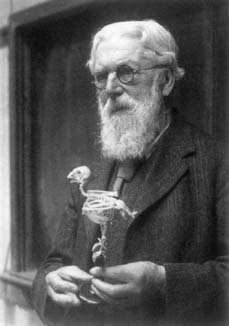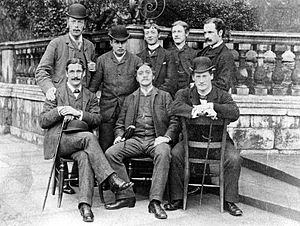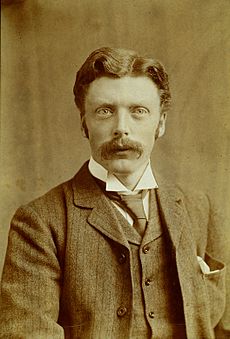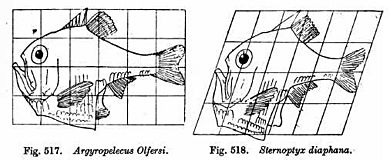D'Arcy Wentworth Thompson facts for kids
Quick facts for kids
D'Arcy Wentworth Thompson
|
|
|---|---|
 |
|
| Born | 2 May 1860 Edinburgh, Scotland
|
| Died | 21 June 1948 (aged 88) |
| Occupation | Mathematical biologist |
| Known for | On Growth and Form |
| Spouse(s) |
Maureen Drury
(m. 1901) |
| Children | 3 daughters |
| Awards | Linnean Medal (1938) Darwin Medal (1946) |
| Scientific career | |
| Fields | Biology, Natural history, Mathematics |
| Institutions | Tertiary education: University of Edinburgh Medical School (medicine) Trinity College, Cambridge (BA) Professional institution: University College, Dundee, University of St Andrews |
Sir D'Arcy Wentworth Thompson (1860–1948) was a Scottish biologist, mathematician, and expert in ancient Greek and Roman culture. He was one of the first scientists to combine biology with mathematics. He explored how living things grow and take shape.
Thompson traveled on important expeditions, like to the Bering Strait. He was a professor of Natural History for many years. He taught at University College, Dundee for 32 years. Later, he taught at St Andrews for 31 years. He received many honors for his work. These included being knighted and winning the Darwin Medal.
Thompson is best known for his 1917 book, On Growth and Form. This book was groundbreaking. It helped explain morphogenesis. This is the scientific process of how patterns and body structures form in plants and animals. His ideas inspired many famous thinkers and artists.
Contents
Life Story of D'Arcy Thompson
Growing Up and School
D'Arcy Thompson was born in Edinburgh, Scotland, on May 2, 1860. His mother, Fanny Gamgee, sadly died soon after he was born. He was raised by his grandfather, Joseph Gamgee, who was a veterinary surgeon.
From 1870 to 1877, he attended The Edinburgh Academy. In 1878, he began studying medicine at the University of Edinburgh. Two years later, he moved to Trinity College, Cambridge. There, he switched to studying zoology, which is the study of animals.
While at Cambridge, D'Arcy Thompson received scholarships. To help pay for his education, he translated a book by Hermann Müller. This book was about how flowers are fertilized. His translation was published in 1883. It even included an introduction by Charles Darwin. He earned his degree in Natural Science in 1883.
His Career as a Professor

From 1883 to 1884, Thompson taught physiology at Cambridge. In 1884, he became a Professor of Biology. This was at University College, Dundee. He stayed there for 32 years. One of his first jobs was to create a Zoology Museum. This museum was for teaching and research. It is now named after him.
In 1885, he became a member of the Royal Society of Edinburgh. He later served as its vice president and president.
In 1896 and 1897, Thompson went on trips to the Bering Straits. He represented the British Government. His job was to investigate the declining numbers of fur seals. His careful work helped prevent problems between Russia and the United States. Both countries had interests in hunting seals there.
His report also highlighted the near extinction of sea otters and whales. He became one of the first to push for agreements to protect species. His ideas helped lead to new protection orders for animals. He also advised the Scottish Fisheries Board.
Thompson collected many valuable specimens for his museum during his travels. His museum became one of the largest in the country. It specialized in Arctic animals. The D'Arcy Thompson Zoology Museum still has a Japanese spider crab he collected. It also has the rare skeleton of a Steller's Sea Cow.

While in Dundee, Thompson also helped his community. He was on the committee for the Dundee Women's Hospital. He also helped found the Dundee Social Union. He pushed for them to buy and fix up old buildings. This allowed poor families in Dundee to have better homes. He supported social reformer Mary Lily Walker in her work.
In 1917, at age 57, Thompson moved to the University of St Andrews. He became the Professor of Natural History there. He stayed in this role for 31 years. In 1918, he gave a famous lecture series. It was called The Fish of the Sea.
A mathematician named Walter Ledermann met Thompson in the 1930s. Ledermann said Thompson enjoyed using math to understand nature. He used advanced math to explain the shapes of living things.
His Family Life
On July 4, 1901, Thompson married Maureen Drury. They had three daughters. His wife and daughters survived him.
D'Arcy Thompson died in St Andrews in 1948. He was 87 years old. He had just returned from a trip to India. He is buried in Dean Cemetery in Edinburgh.
His Important Books
Translating History of Animals
In 1910, Thompson published his translation of Aristotle's History of Animals. This was a huge project. He had worked on it for many years. Earlier translations were not very accurate.
Thompson's version was much better. He knew Greek very well. He was also an expert in zoology. He understood Aristotle's biology deeply. His translation was correct, clear, and easy to read.
His Famous Book: On Growth and Form
Thompson's most famous book is On Growth and Form. It helped explain morphogenesis. This is how living things get their shapes and structures. He wrote most of it in 1915. It was published in 1917.
The main idea of the book is that evolution alone doesn't explain everything. Thompson believed that physical laws and mechanical forces were also very important. He thought these forces helped shape plants and animals. He had criticized Darwinism before. He felt it didn't fully explain how new species got their forms.
Thompson showed how different parts of an organism grow at different rates. This changes its overall shape. He used many examples to show this. He compared the shapes of jellyfish to drops of liquid. He also looked at the strong internal structures in bird bones. These were similar to engineering designs. He also studied phyllotaxis. This is the pattern of spirals in plants. He linked it to the Fibonacci sequence.
A very famous part of the book is Chapter XVII. Here, Thompson showed how related animals' shapes could be described. He used simple mathematical transformations. For example, he could show how one fish's shape could be stretched or squeezed to become another fish's shape.
The book is mostly descriptive. Thompson didn't create experiments to test his ideas. He knew this, saying his book was "all preface."
Awards and Recognition
D'Arcy Thompson received many honors for his work.
- He became a member of the Royal Society in 1916.
- He was made an honorary member of the American Academy of Arts and Sciences in 1928.
- He was knighted in 1937, becoming "Sir D'Arcy Thompson."
- He received the Gold Medal of the Linnean Society in 1938.
- In 1941, he joined the American Philosophical Society.
- He was awarded the Darwin Medal in 1946.
- For his updated On Growth and Form, he received the Daniel Giraud Elliot Medal in 1942.
- He was a very active member of the Royal Society of Edinburgh. He was its president from 1934 to 1939.
His Lasting Impact
Inspiring Other Thinkers
On Growth and Form has inspired many important people. These include biologists like Julian Huxley. Mathematicians like Alan Turing were also influenced. Artists like Eduardo Paolozzi found inspiration in his ideas. They were fascinated by the math behind animal shapes.
Thompson's "Theory of Transformations" was especially influential. It showed how related species' shapes could be linked by geometry. This idea was a step towards evolutionary developmental biology. This field studies how evolution shapes development.
His book led Alan Turing to write a famous paper. It was called "The Chemical Basis of Morphogenesis." It explored how patterns on animal skins might form from simple chemical systems.
Architects also admire On Growth and Form. They like how it explores natural shapes and growth. Famous architects like Le Corbusier and Mies van der Rohe were inspired by the book. Peter Medawar, a Nobel Prize winner, called it "the finest work of literature in all the annals of science."
Celebrating His Legacy
In 2010, people celebrated the 150th anniversary of his birth. Events and exhibitions were held at the Universities of Dundee and St Andrews. A lecture hall at the University of Dundee was renamed in his honor. An exhibition about his work was also held.
His Museum and Papers
The original D'Arcy Thompson Zoology Museum in Dundee was not well cared for after he left. In 1956, the building was set to be torn down. The museum collection was split up. Some parts went to the British Museum. A teaching collection was kept. This forms the basis of the current D'Arcy Thompson Zoology Museum at the University of Dundee.
In 2011, the University of Dundee received a grant. It was to build a collection of art inspired by Thompson's ideas. Much of this art is displayed in the museum.
Thompson's personal papers are kept at the University of St Andrews. There are over 30,000 items. The University of Dundee also has records from his time there.
In 1892, D'Arcy Thompson gave many specimens to the Cambridge University Museum of Zoology. These included crustaceans and sea spiders.
Images for kids





